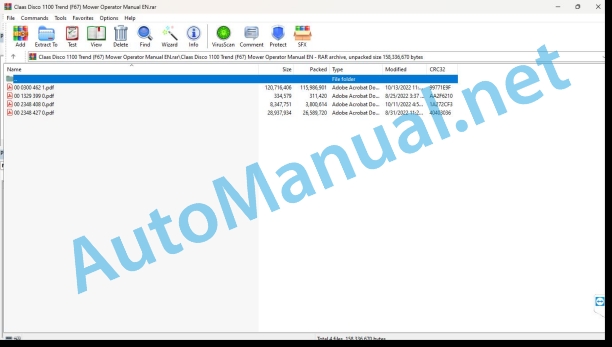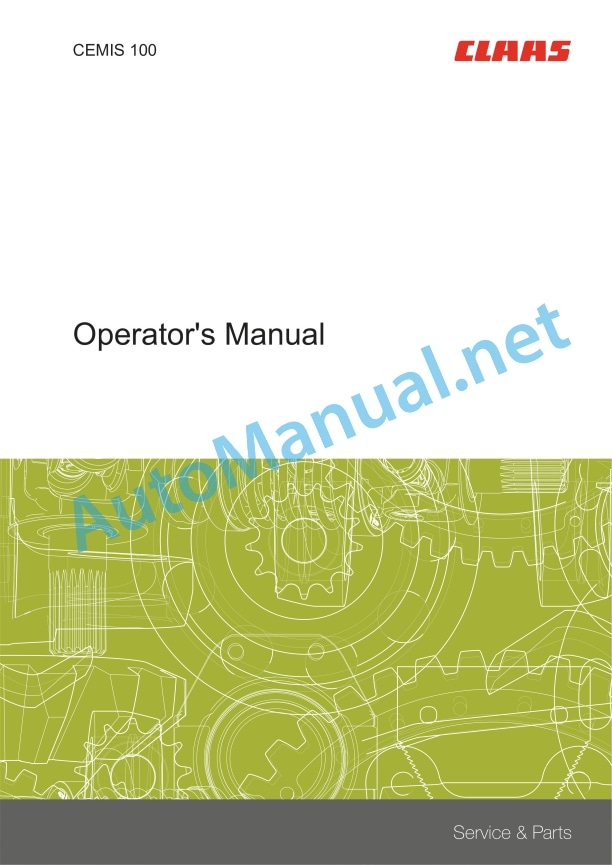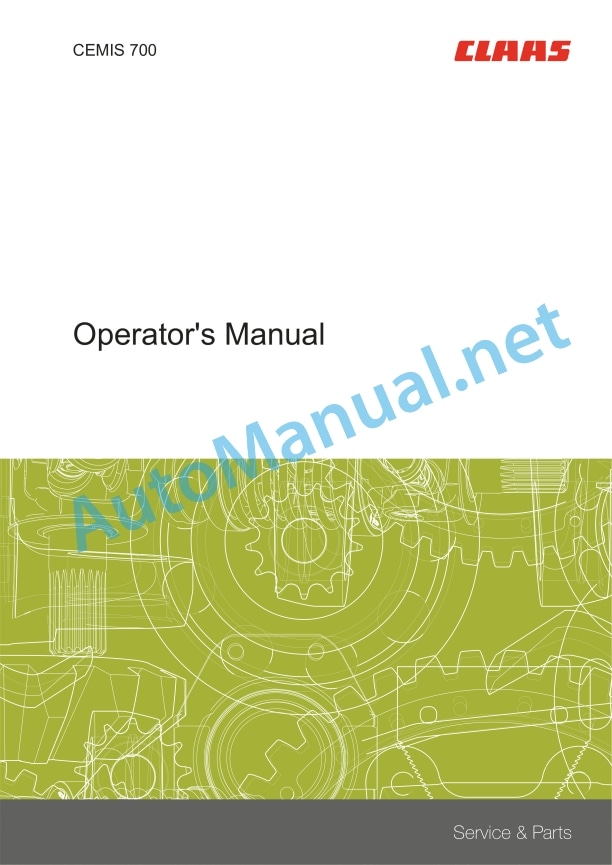Claas Disco 1100 Trend (F67) Mower Operator Manual EN
$50.00
- Model: Disco 1100 Trend (F67) Mower
- Type Of Manual: Operator Manual
- Language: EN
- Format: PDF(s)
- Size: 140 MB
File List:
00 0300 462 1.pdf
00 1329 399 0.pdf
00 2348 408 0.pdf
00 2348 427 0.pdf
00 0300 462 1.pdf:
DISCO 1100 TREND
Table of contents
1 Introduction
1.1 Notes on the manual
1.1.1 Validity of the manual
1.1.2 Information about this Operator’s Manual
1.1.3 Symbols and notices
1.1.4 Optional equipment
1.1.5 Qualified specialist workshop
1.1.6 Notes on warranty
1.1.7 Spare parts and technical questions
1.2 Intended use
1.2.1 Intended use
1.2.2 Reasonably foreseeable misuse
2 Safety
2.1 Identifying warnings
2.1.1 Hazard signs
2.1.2 Signal word
2.2 Safety rules
2.2.1 Importance of Operator’s Manual
2.2.2 Observing safety decals and warnings
2.2.3 Requirements for all persons working with the machine
2.2.4 Children in danger
2.2.5 Hazard areas
2.2.6 Staying between the tractor and the machine
2.2.7 Hitching the tractor to the machine
2.2.8 Risk of injury from rotating shafts
2.2.9 Structural changes
2.2.10 Optional equipment and spare parts
2.2.11 Control of the machine while it is running
2.2.12 Operation only after proper putting into operation
2.2.13 Technical condition
2.2.14 Danger due to damage to the machine
2.2.15 Respecting technical limit values
2.2.16 Danger from machine parts running on
2.2.17 Keeping protective equipment functional
2.2.18 Personal protective equipment
2.2.19 Wearing suitable clothing
2.2.20 Removing dirt and loose objects
2.2.21 Preparing the machine for road travel
2.2.22 Hazards when driving on the road and in the field
2.2.23 Parking the machine safely
2.2.24 Unsupervised parking
2.2.25 Unsuitable operating materials
2.2.26 Safe handling of operating and auxiliary materials
2.2.27 Environmental protection and disposal
2.2.28 Lethal electrocution from overhead lines
2.2.29 Behaviour in case of voltage flash-over from overhead lines and when lightning strikes
2.2.30 Noise may cause health damage
2.2.31 Liquids under pressure
2.2.32 Hot surfaces
2.2.33 Only carry out work on the machine when it is stopped
2.2.34 Maintenance operations and repairs
2.2.35 Lifted machine parts and loads
2.2.36 Danger from welding work
2.3 Safety decals on the machine
2.3.1 Layout of safety decals
2.3.2 Safety decals on the machine
3 Machine description
3.1 Overview and method of operation
3.1.1 Machine overview
3.1.2 Overview of the cutting disc direction of rotation
3.1.3 Functions of the DISCO 1100 TREND
3.2 Optional equipment
3.2.1 High-cut skids*
3.2.2 Double high-cut skids*
3.2.3 Wear skids*
3.2.4 Bar protection*
3.2.5 Outer swath disc*
3.2.6 Slip-on yoke for 21-piece universal drive shaft*
3.2.7 Adapter balls, category IV*
3.2.8 Hydraulic system connectors, 3-fold*
3.2.9 Work lights*
3.2.10 Lighting adapter for USA*
3.2.11 Legal equipment for France*
3.3 Identification plate and vehicle identification number
3.3.1 Spare parts and technical questions
3.3.2 Machine identification plate
3.4 Information on the machine
3.4.1 Stickers on the machine
4 Operating and display elements
4.1 Controls
4.1.1 Attachable frame
4.1.2 Control terminal
4.2 Display elements
4.2.1 Pressure gauge
4.2.2 Adjusting aid
5 Technical specifications
5.1 DISCO 1100 TREND
5.1.1 Dimensions
5.1.2 Weights
5.1.3 Requirements for the tractor
5.1.4 Version
5.1.5 Noise level
5.1.6 Lubricants
6 Machine preparation
6.1 Switching off and securing the machine
6.1.1 Switching off and securing the tractor and machine
6.1.2 Securing the raised machine
6.2 Adapting the tractor
6.2.1 Checking the ballasting of the tractor
Calculating the minimum front ballast
Calculating the minimum rear ballast
Calculating the actual front axle load
Calculating the actual total weight
Calculating the actual rear axle load
Calculation table
6.3 Adapting the machine
6.3.1 Universal drive shaft – checking the length
6.3.2 Adapting the length of the universal drive shaft
6.3.3 Fitting the universal drive shaft to the machine
6.3.4 Adapting the lower and upper link category
Adapting the lower link category
Adapting the upper link category
6.3.5 Adapting the lower link pin position
6.3.6 Adjust the position of the upper link pin
6.3.7 Installing the high-cut skids*
6.3.8 Removing the high-cut skids*
6.3.9 Attaching the double high-cut skids*
6.3.10 Installing wear skids*
6.3.11 Adapting the overlap
6.4 Hitching the machine
6.4.1 Fitting the lower link
6.4.2 Fitting the upper link
6.4.3 Installing the universal drive shaft
6.4.4 Attaching the hydraulic hose connections for the hydraulic lift
6.4.5 Connecting the hydraulic hose lines for the telescopic supporting arms
6.4.6 Attach the hydraulic hose connections for load relief
6.4.7 Connecting the lighting cable
6.4.8 Raising the stands
6.4.9 Connecting the control terminal
6.5 Unhitching the machine
6.5.1 Disconnecting the control terminal
6.5.2 Lowering the stands
6.5.3 Disconnecting the lighting cable
6.5.4 Disconnecting the hydraulic hose line for the load relief
6.5.5 Disconnecting the hydraulic hose lines for the telescopic supporting arms
6.5.6 Disconnecting the hydraulic hoses for lifting
6.5.7 Removing the universal drive shaft
Safety fastening
QS fastening
6.5.8 Unhooking the upper link
6.5.9 Unhooking the lower link
6.6 Prepare road travel
6.6.1 Performing checks prior to road travel
6.7 Loading the machine
6.7.1 Loading the machine
7 Operation
7.1 Driving on the road
7.1.1 Driving on public roads
7.1.2 Transport width with double high-cut skids* fitted
7.2 Fieldwork settings
7.2.1 Adjusting the mounting frame
7.2.2 Adjusting the load relief of the mower units
7.2.3 Adjusting the outer swath disc*
7.2.4 Adjusting the cutting height
7.2.5 Tensioning the collision protection
7.3 Fieldwork
7.3.1 Lifting to transport position
Folding the safety frames into the transport position and retracting the telescopic supporting arms
Locking the transport safety equipment
7.3.2 Lowering to working position
Folding the safety frames into the working position
7.3.3 Fieldwork
7.3.4 Machine use
7.3.5 Adapting the PTO shaft speed
7.3.6 Mowing methods
7.3.7 Adapting the working width
7.3.8 Headland position
Lifting to the headland position
Lowering from the headland position
Lifting the machine above the headland position
7.3.9 Lifting the mower units individually
7.3.10 Instructions for mowing
7.3.11 Difficult operating conditions
7.3.12 Recommendation for environmental protection
8 Faults and remedies
8.1 Overview of problems
8.1.1 Overview of problems on the machine
8.2 Emergency operation
8.2.1 Notes on emergency operation
8.2.2 Overview of hydraulic valves
8.2.3 Procedures prior to emergency operation
8.2.4 Actuating hydraulic valves manually
8.3 Electrical and electronic system
8.3.1 Defective incandescent lamps
8.4 Universal drive shaft
8.4.1 Running noises at the universal drive shafts
8.5 Mower unit
8.5.1 The cutting disc no longer turns
8.6 Assembly parts and bodywork
8.6.1 The sliding faces of the telescopic supporting arms do not operate smoothly
8.6.2 Telescopic supporting arms do not extend
9 Maintenance
9.1 Service interval overview
9.1.1 Before the harvest
9.1.2 After the first 10 operating hours
9.1.3 After the first 50 operating hours
9.1.4 Every 8 operating hours
9.1.5 Every 20 operating hours
9.1.6 Every 50 operating hours
9.1.7 Every 100 operating hours
9.1.8 Every 250 operating hours
9.1.9 Every 500 operating hours or annually
9.1.10 Every 5 years
9.1.11 After the harvest
9.2 Gearbox
9.2.1 Checking the gearbox for leaks
9.2.2 Checking the oil level in the main gearbox
9.2.3 Change the oil in the main gearbox
Draining oil
Topping up oil
9.2.4 Checking the angle drive oil level
9.2.5 Changing the oil in the angle drive
Draining oil
Topping up oil
9.3 Clutch
9.3.1 Checking the overload clutch
9.3.2 Removing the friction clutch
9.3.3 Attaching the friction clutch
9.3.4 Venting the friction clutch
9.3.5 Checking the friction discs
9.3.6 Clean the friction clutches for the universal drive shafts
9.4 Universal drive shaft
9.4.1 Servicing the universal drive shafts
9.5 Hydraulic system
9.5.1 Reducing the pressure in the hydraulic system
9.5.2 Checking the hydraulic hoses
9.5.3 Checking the accumulator
9.5.4 Removing the load relief cylinders
9.5.5 Attaching the load relief cylinder
9.5.6 Checking the break back device
9.6 Mower unit
9.6.1 Checking the oil level in the mower heads
9.6.2 Changing the mower head oil
Draining oil on the right and left
Filling in oil on the right and left
9.6.3 Check the mower knives
9.6.4 Replacing the mower knives
9.6.5 Check the mower knife holder
9.6.6 Check the adapters
9.6.7 Clean the drain opening of the feed drum
9.6.8 Check the feed drum wear bars
9.6.9 Check the cover plate on the feed drum
9.6.10 Check the sealing washer of the feed drum
9.6.11 Check the cutting discs
9.6.12 Replacing the cutting discs
9.6.13 Adjust the anti-wrap guard
9.7 Assembly parts and bodywork
9.7.1 Clean the machine
9.7.2 Preserve the machine
9.7.3 Check the fittings
9.7.4 Check the play of the telescopic supporting arms
9.7.5 Checking the inner guide of the telescopic supporting arms
9.7.6 Checking the telescopic supporting arm buffer
9.7.7 Checking the stop bars of the telescopic supporting arms
9.7.8 Checking the pressure switch for the telescopic supporting arms
9.7.9 Check the pressure switch for the safety frame
9.7.10 Check the safety guard holder
Tightening torques for the hex. nuts (3)
9.8 Lubrication plan
9.8.1 Lubricating the grease points every 8 operating hours
9.8.2 Lubricating the grease points every 20 operating hours
9.8.3 Lubricating grease points every 100 operating hours
9.8.4 Lubricating grease points every 250 operating hours
10 Putting out of operation and disposal
10.1 General information
10.1.1 Placing out of operation and disposal
11 EC declaration of conformity
11.1 DISCO 1100 TREND
11.1.1 EC Declaration of Conformity
12 Technical terms and abbreviations
12.1 Terms and explanations
12.1.1 Technical terms
12.1.2 Abbreviations
00 2348 408 0.pdf:
CEMIS 100
Table of contents
1 Introduction
1.1 General information
1.1.1 Validity of the manual
1.1.2 Information about this Operator’s Manual
1.1.3 Symbols and notes
1.2 Intended use
1.2.1 Intended use
1.2.2 Reasonably foreseeable misuse
2 Safety
2.1 Safety rules
2.1.1 General safety and accident prevention regulations
2.1.2 Interaction between terminal and machine or tractor
2.1.3 Electrocution by electrical system
3 Product description
3.1 Overview and method of operation
3.1.1 Overview of CEMIS 100
3.1.2 Function principle of CEMIS 100
3.2 Identification plates and identification numbers
3.2.1 Spare parts and technical questions
3.2.2 Identification plate of CEMIS 100
4 Operating and display elements
4.1 CEMIS 100
4.1.1 User interface for LINER
4.1.2 User interface for ROLLANT
4.1.3 User interface for UNIWRAP
5 Technical specifications
5.1 CEMIS 100
5.1.1 Specification
6 Operation
6.1 CEMIS 100
6.1.1 Operating the CEMIS 100
6.1.2 Switching CEMIS 100 on
6.1.3 Switching CEMIS 100 off
7 Maintenance
7.1 CEMIS 100
7.1.1 Daily
8 Putting out of operation and disposal
8.1 General information
8.1.1 Removal from service and disposal
9 Technical terms and abbreviations
9.1 Terms and explanations
9.1.1 Technical words
9.1.2 Abbreviations
00 2348 427 0.pdf:
CEMIS 700
Table of contents
1 Introduction
1.1 General information
1.1.1 Validity of the manual
1.1.2 Information about this Operator’s Manual
1.1.3 Symbols and notes
1.2 Intended use
1.2.1 Intended use
1.2.2 Reasonably foreseeable misuse
2 Safety
2.1 Safety rules
2.1.1 General safety and accident prevention regulations
2.1.2 Interaction between terminal and machine or tractor
2.1.3 Electrocution by electrical system
3 Product description
3.1 Overview and method of operation
3.1.1 Overview of CEMIS 700
3.1.2 Function principle of CEMIS 700
3.2 Identification plates and identification numbers
3.2.1 Spare parts and technical questions
3.2.2 Identification plate of CEMIS 700
4 Information on the product
4.1 Software version
5 Operating and display elements
5.1 CEMIS 700
5.1.1 User interface
5.1.2 Terminal program
6 Technical specifications
6.1 CEMIS 700
6.1.1 Specification
7 Operation
7.1 CEMIS 700
7.1.1 Operating the CEMIS 700
7.1.2 Switching CEMIS 700 on
7.1.3 Switching CEMIS 700 off
7.2 Terminal settings
7.2.1 Making settings
Making settings with the rotary button
Making settings with the touch function
7.2.2 Setting the screen lighting
Daytime mode
Nighttime mode
Activating automatic key lighting
7.2.3 Setting the time and date
7.2.4 Displaying diagnosis information
On-board power supply voltage display
Display of CLAAS ISOBUS ECU address and name
7.2.5 Setting the language and display formats
Setting the language
Setting display formats
7.2.6 Setting the volume
7.2.7 Deleting an ISOBUS implement
8 Maintenance
8.1 Maintenance
8.1.1 Daily
9 Putting out of operation and disposal
9.1 General information
9.1.1 Removal from service and disposal
10 Technical terms and abbreviations
10.1 Terms and explanations
10.1.1 Technical words
10.1.2 Abbreviations
John Deere Repair Technical Manual PDF
John Deere Diesel Engines POWERTECH 2.9 L Component Technical Manual CTM126 Spanish
John Deere Parts Catalog PDF
John Deere Tractors 6300, 6500, and 6600 Parts Catalog CQ26564 (29SET05) Portuguese
John Deere Repair Technical Manual PDF
John Deere Application List Component Technical Manual CTM106819 24AUG20
John Deere Repair Technical Manual PDF
John Deere Repair Technical Manual PDF
John Deere 16, 18, 20 and 24HP Onan Engines Component Technical Manual CTM2 (19APR90)
John Deere Parts Catalog PDF
John Deere Tractors 7500 Parts Catalog CPCQ26568 30 Jan 02 Portuguese
John Deere Parts Catalog PDF
John Deere Harvesters 8500 and 8700 Parts Catalog CPCQ24910 Spanish
John Deere Repair Technical Manual PDF
John Deere Repair Technical Manual PDF
John Deere Repair Technical Manual PDF

























